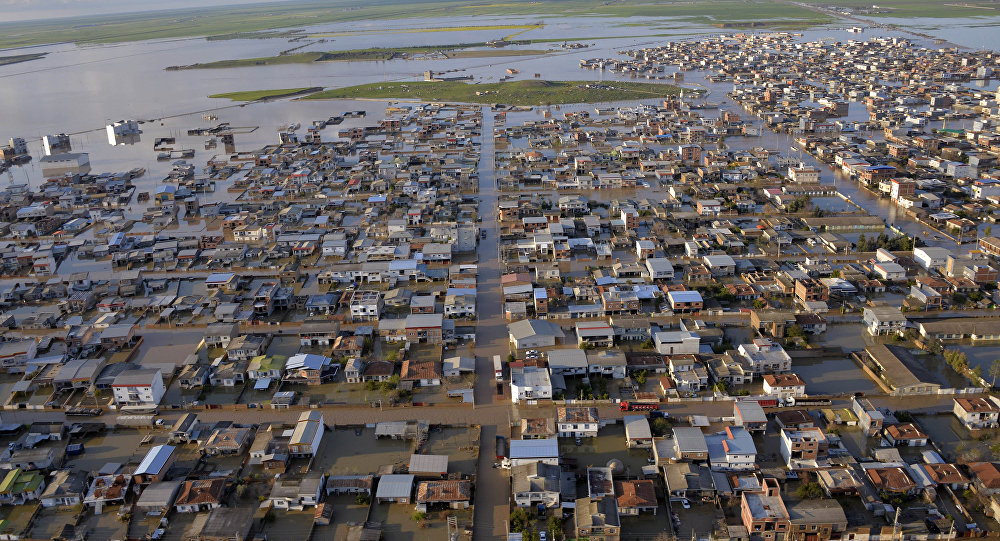الفيضانات والملالي وسندريلا
أمير طاهري/الشرق الأوسط/05 نيسان/19
The Floods, the Mullahs and the Cinderella in Boots
Amir Taheri/Asharq Al Awsat/April 05/19
It may take weeks if not months before the full facts of the current nationwide floods in Iran are established. But we already know that the floods represent one of the biggest natural disasters Iran has suffered in half a century.
According to provisional data from the Islamic Red Crescent the floods struck in over 300 towns and cities in 22 of Iran’s 31 provinces, affecting 18.5 million people, almost a quarter of the nation’s total population. Some 1.2 million people have been made homeless, at least temporarily.
The damage done to infrastructure across the nation is equally massive. With 141 rivers in flood and some 500 landslides over 3,000 kilometers of roads and highways connecting thousands of villages and 78 medium or large cities have been partly or totally destroyed.
Also destroyed are 87 bridges, 160 dams and over 1,000 kilometers of railway lines. The floods have put over 18,000 factories and workshops out of action while the damage done to farming is described as “incalculable.”
From a broader point of view perhaps, the natural disaster has also revealed some of the fundamental weaknesses of a dysfunctional system that, having devoted its principal resources and much of its energies to promoting a weird ideology, seems to be incapable of coping with basic tasks of a normal nation-state.
It took the parallel authorities that coexist in Tehran more than 48 hours before they realized what was going on, giving the state-controlled media the green light to report on it.
Then it took another two days before the various duplicating organs of the state, decided who was supposed to do what. President Hassan Rouhani, spending a weeklong holiday in the island resort of Qishm appeared beyond reach. “Supreme Guide” Ali Khamenei, too busy with a poetry gathering, was unavailable for days, and found it unnecessary even to comment.
The Iranian Revolutionary Guard Corps (IRGC), often boasting about its imaginary conquests in Iraq, Syria, Lebanon and Yemen and promising to hoist the flag of Khomeinism in Washington, was forced to intervene not to save the stricken citizens but to protect some of the infrastructures it has built and runs as businesses.
It was soon revealed that those infrastructures, including railway lines built in traditional flood channels and dams hastily erected in wrong places and wrong rivers massively contributed to the floods.
The IRGC has built over 300 crude dams to divert waters of various rivers to land it had seized and transferred to active and/or retried officers.
In a strategy that recalls that of the Chavista in Venezuela, the IRGC has also helped many peasants, seen as part of the regime’s support base, to cut down large tracts of forests, further raising the risk of flood.
More than a week after the disaster had struck, using thinly veiled words, Rouhani put the blame on IRGC’s cowboy style “social” building projects and profiteering schemes. IRGC chief General Muhammad-Ali Aziz-Jaafari riposted by accusing Rouhani’s Cabinet of incompetence and poor leadership.
The failure of the official government led by Rouhani and the unofficial one led by Gen. Jaafari, both under Khamenei’s ultimate control, at least theoretically, provided a space for other actors to jump in.
The first to do so was the national army which, since the mullahs seized power in 1979, has been treated as a Cinderella in boots.
Iranians watched in amazement as special units of the regular army moved to save lives, prevent floods from spreading further, reopen roads and even start repairing some of the damage. Buoyed by the presence of regular army units thousands of volunteers also poured in to help deal with the disaster. Contacts across Iran describe the solidarity shown by average citizen as “exemplary”, implying that Iran deserves a better government.
The IRGC reacted by ferrying in dozens of ”Madaheen”, professional reciters of religious chants whose patron is Khamenei. The “Madaheen” jumped into flood waters chanting “Suffering makes us strong!” and “We are not afraid of death” while beating their chests the way they do when they mourn the martyr Imam Hussein at Muharram.
In some places they were accompanied by women who attend Muharram mourning sessions as “tear-shedding assistants.”
The parallel governments also spent time debating whether or not to appeal for outside assistance.
While the official foreign ministry awaited instructions regarding contact with the International Red Cross and other aid agencies, the unofficial foreign ministry, located in Khamenei’s office, decided that “those who know how to mourn Hussein” need not humiliate themselves by shaking a begging bowl at ”Cross-Worshippers and Zionists.” In the Bam earthquake in 2003 over 60 countries rushed to help Iran cope with the disaster.
The façade government, led by President Muhammad Khatami had welcomed foreign aid. That had angered the “Supreme Guide”.
“How could we humiliate Islam in the face of the Infidel?” Khamenei had demanded.
This time, however, the façade government, headed by the hapless Rouhani, dared not defy the “Supreme Guide”. Rouhani’s First Assistant Eshaq Jahangiri had this to say: “A country as rich as the Islamic Republic has no need of foreign assistance.”
However, to fool his American apologists, Muhammad Javad Zarif, the man who plays the role of foreign minister, still had to blame the United States for lack of any foreign assistance or even sympathy.
“American sanctions prevent help from reaching Iran,” Zarif’s spokesman said last Monday.
However, everyone knows that humanitarian aid as well as food and medicine and other items of trade with no probable military use are not covered by the US, the European Union and the United Nations sanctions.
In any case there is no sanction against a foreign leader, our dear friend President Vladimir Putin for example, phoning someone in Tehran to express condolences and sympathy.
The problem is that Putin wouldn’t know who to phone in Tehran: Rouhani the mullah who plays as president or Khamenei who may feel insulted if he is told there has been a catastrophe in his “Islamic” paradise?
الفيضانات والملالي وسندريلا
أمير طاهري/الشرق الأوسط/05 نيسان/19
ربما يستغرق الأمر أسابيع، إن لم يكن شهوراً، قبل أن تتكشف كامل الحقائق بخصوص الفيضانات التي تجتاح مختلف أرجاء إيران. ومع هذا، فإننا نعلم بالفعل أن الفيضانات الحالية تشكّل واحدة من كبرى الكوارث الطبيعية التي عانتها إيران على امتداد نصف قرن.
وتبعاً للبيانات الأولية الصادرة عن منظمة الصليب الأحمر، ضربت الفيضانات ما يزيد على 300 مدينة داخل 22 محافظة من إجمالي 31 محافظة إيرانية، ما تسبب في تضرر 18.5 مليون شخص يمثلون قرابة ربع إجمالي السكان. وأصبح 1.2 مليون شخص مشردين، على الأقل بصورة مؤقتة.
ولا تقل الأضرار التي أصابت البنية التحتية للبلاد فداحةً، ذلك أن حالةً من الفيضان تسود 141 نهراً ووقعت 500 حالة انزلاق أرضي على امتداد مساحة 3.000 كيلومتر من الطرق العادية والسريعة تربط آلاف القرى، إضافة إلى تعرض 78 مدينة متوسطة أو كبيرة الحجم لتدمير جزئي أو كلي.
كما تشمل قائمة الأضرار 87 جسراً و160 سداً وما يزيد على 1000 كيلومتر من خطوط السكك الحديدية. أيضاً، تسببت الفيضانات في تعطيل أكثر عن 18 ألف مصنع وورشة، بينما تصف التقديرات الأضرار التي أصابت قطاع الزراعة بأنها «لا تقدَّر بثمن».
ومن منظور أوسع، ربما كشفت هذه الكارثة الطبيعية النقاب عن بعض أوجه الضعف الجوهرية في نظام يعاني خللاً وظيفياً، وكرّس الجزء الأساسي من موارده وكثيراً من طاقته للترويج لآيديولوجيا غريبة، ويبدو عاجزاً عن التكيف مع المهام الأساسية لأي دولة قومية طبيعية.
اللافت أن الأمر استغرق من السلطات الموازية القائمة في طهران أكثر عن 48 ساعة كي تدرك حقيقة ما يجري وإعطاء وسائل الإعلام الرسمية الضوء الأخضر للحديث عنه.
بعد ذلك، استغرق الأمر يومين آخرين قبل أن تقرر أذرع الدولة الكثيرة مَن يُفترض منه الاضطلاع بماذا. أما الرئيس حسن روحاني الذي كان يقضي عطلة لمدة أسبوع في منتجع بجزيرة قيشم، فبدا من المتعذر الوصول إليه، في الوقت الذي كان المرشد آية الله علي خامنئي مشغولاً للغاية في تجمع شعري وظل غير متاح لعدة أيام، بل ووجد الأمر لا يستحق عناء إصدار تعليق بشأنه.
من جهته، وجد «الحرس الثوري»، الذي غالباً ما يتفاخر بفتوحاته الوهمية في العراق وسوريا ولبنان واليمن ويعد برفع لواء الخمينية في واشنطن، نفسه مضطراً إلى التدخل ليس لإنقاذ المواطنين المتضررين، وإنما لحماية بعض عناصر البنية التحتية التي بناها ويديرها كمشروعات تجارية.
وسرعان ما اتضح أن تلك البنى التحتية، بما في ذلك خطوط السكك الحديدية التي بُنيت في مسارات طبيعية للسيول وسدود جرى تشييدها بسرعة في أماكن خاطئة وعلى أنهار خاطئة، أسهمت في تفاقم كارثة الفيضانات.
كان الحرس الثوري قد بني ما يزيد على 300 سد لتحويل مسار مياه العديد من الأنهار باتجاه أراضٍ استولى عليها ونقل ملكيتها إلى ضباط حاليين أو متقاعدين.
وفي استراتيجية تحمل أصداء التشافيزية في فنزويلا، ساعد «الحرس الثوري» كذلك الكثير من المزارعين الذين يجري النظر إليهم باعتبارهم جزءاً من قاعدة تأييد النظام، على القضاء على مساحات واسعة من الغابات، ما تسبب في تفاقم مخاطر الفيضانات.
وبعد أكثر من أسبوع على وقوع الكارثة، وباستخدام كلمات مبهمة بعض الشيء، ألقى روحاني باللوم على المشروعات «الاجتماعية» التي شيدها «الحرس الثوري» ونشاطات التربح التي خاضها. ورد قائد «الحرس الثوري» الجنرال محمد علي عزيز جعفري، على ذلك باتهام حكومة روحاني بالافتقار إلى الكفاءة والمهارات القيادية المناسبة. وكان من شأن إخفاق الحكومة الرسمية بقيادة روحاني والأخرى غير الرسمية بقيادة الجنرال جعفري، وكلتاهما تحت قيادة خامنئي، نظرياً على الأقل، إفساح المجال أمام عناصر أخرى للقفز إلى داخل المشهد.
كان أول مَن فعل ذلك الجيش الوطني الذي منذ سيطرة الملالي على السلطة عام 1979، جرى التعامل معه على نحو أشبه بسندريلا. وتابع الإيرانيون في انبهار فرقاً خاصة من الجيش النظامي تتحرك لإنقاذ الأرواح والحيلولة دون تقدم الفيضانات نحو مساحات أكبر، وإعادة فتح الطرق، بل والشروع في إصلاح بعض المنشآت المتضررة. وشجع وجود وحدات من الجيش النظامي آلاف المتطوعين على التدفق على المناطق المنكوبة للمعاونة في التصدي للكارثة. ويصف الكثيرون بمختلف أرجاء البلاد روح التضامن التي أبداها المواطنون العاديون بأنها شكّلت «نموذجاً يُضرَب به المثل»، في إشارة ضمنية إلى أن إيران تستحق حكومة أفضل. من جهته، استجاب «الحرس الثوري» لذلك عبر نشر العشرات من «المداحين» الذين يلقون أناشيد دينية ويعتبرون خامنئي الأب الروحي لهم. وقفز «المداحون» في مياه الفيضانات وهم ينشدون «المعاناة تجعلنا أقوياء!» و«لا نخشى الموت»، بينما يضربون صدورهم بأيديهم مثلما يفعلون لدى إحياء ذكرى استشهاد الإمام الحسين في شهر محرّم.
وفي بعض الأماكن، رافقتهم سيدات ممن يشاركن في جلسات العزاء في محرّم وينخرطن في الندب والبكاء.
علاوةً على ذلك، دخلت الحكومات المتوازية في جدال حول ما إذا كان ينبغي طلب مساعدة أجنبية. وفي الوقت الذي انتظرت وزارة الخارجية التعليمات فيما يخص التواصل مع منظمة «الصليب الأحمر» ووكالات الإغاثة الأخرى، قررت وزارة الخارجية غير الرسمية التي يوجد مقرها في مكتب خامنئي أن «من يعرفون كيفية إظهار الحداد على الحسين» ليسوا بحاجة إلى إذلال أنفسهم عبر التسول من «عبدة الصليب والصهاينة».
جدير بالذكر أنه في خضمّ كارثة زلزال بام عام 2003، سارع أكثر من 60 دولة لمعاونة إيران على التصدي للكارثة. في ذلك الوقت، رحبت الحكومة الواجهة آنذاك بقيادة الرئيس محمد خاتمي، بالمساعدات الأجنبية، الأمر الذي أغضب المرشد خامنئي الذي تساءل: «كيف يمكن أن نذلّ الإسلام أمام الكفار؟».
إلا أنه هذه المرة، لم تجرؤ حكومة الواجهة بقيادة روحاني على تحدي المرشد. من جانبه، صرح المساعد الأول لروحاني إسحاق جهانغيري بأن «دولة في ثراء الجمهورية الإسلامية ليست بحاجة إلى مساعدات أجنبية».
ومع هذا، ألقى محمد جواد ظريف، الذي كان يتولى دور وزير الخارجية، باللوم على الولايات المتحدة عن نقص المساعدات الأجنبية وعدم إظهارها ولو حتى التعاطف.
وقال المتحدث الرسمي باسم ظريف، الاثنين الماضي: «تمنع العقوبات الأميركية وصول المساعدات لإيران». ويأتي ذلك على الرغم من أن الجميع يعرفون أن المساعدات الإنسانية والطعام والدواء ومواد تجارية أخرى ليس لها استخدام عسكري محتمَل، لا تندرج تحت مظلة العقوبات التي تفرضها أيٌّ من الولايات المتحدة أو الاتحاد الأوروبي أو الأمم المتحدة. على أي حال، ليست هناك عقوبات ضد زعيم أجنبي مثل الرئيس فلاديمير بوتين تمنعه من الاتصال هاتفياً بمسؤول في طهران ليعرب عن تعازيه وتعاطفه. إلا أن المشكلة تكمن في أن بوتين لن يدري مَن يتعين عليه الحديث إليه في طهران: روحاني، الملا الذي يلعب دور الرئيس، أم خامنئي الذي ربما يشعر بالإهانة إذا أخبره بوتين أن ثمة «كارثة» تعصف بجنته «الإسلامية»؟




















